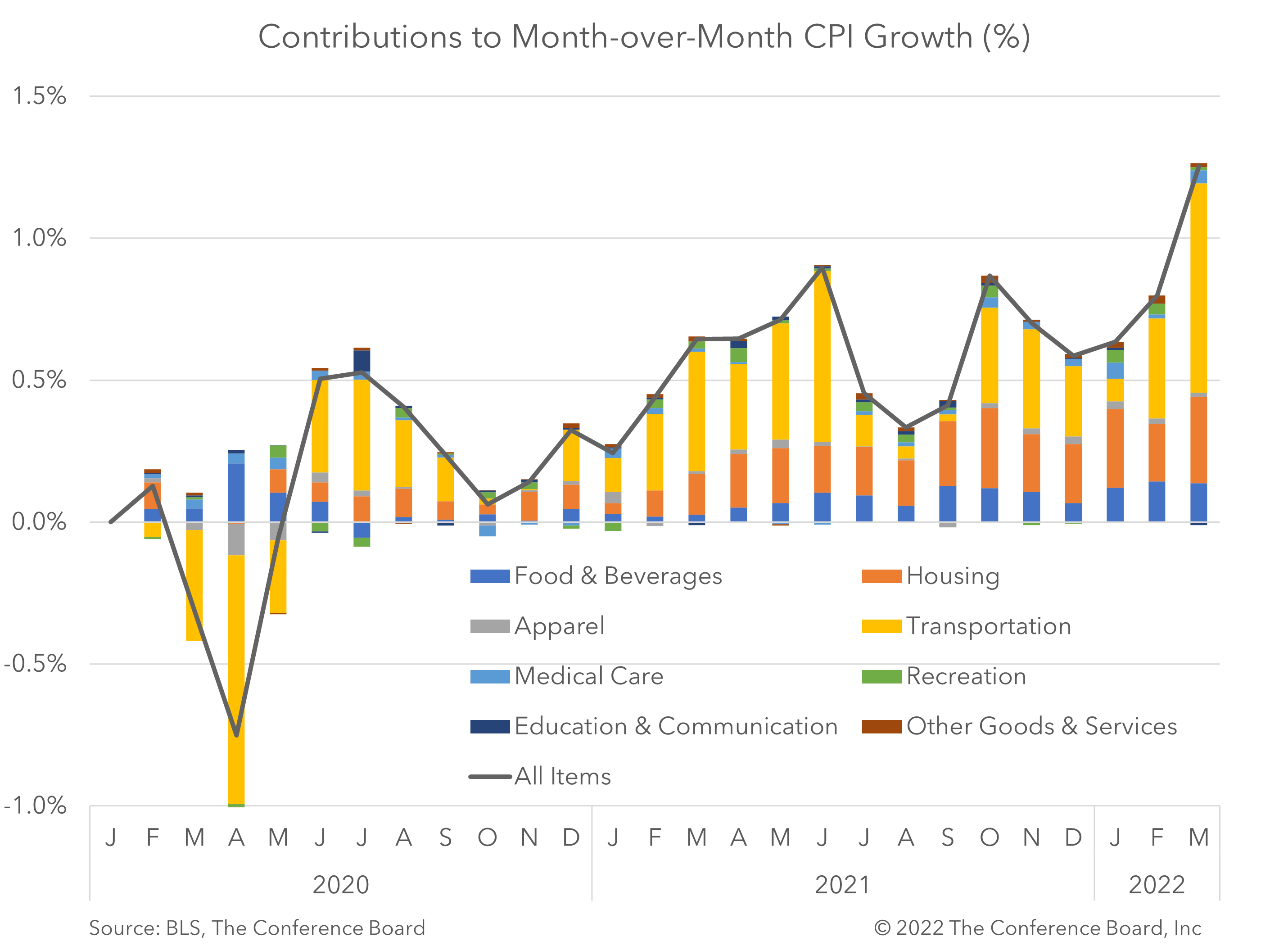
The Consumer Price Index (CPI) rose to 8.5 percent year-over-year in March, vs. an increase of 7.9 percent year-over-year in February. This key measure of consumer price inflation is now at the highest rate recorded since December 1981. Core CPI, which excludes volatile food and energy prices, rose by 6.5 percent year-over-year, vs. 6.4 percent in February. On a month-over-month basis, March CPI rose 1.2 percent, vs. 0.8 percent February. Meanwhile, March Core CPI rose 0.3 percent, vs. 0.5 percent in February. This large divergence shows that food and energy prices have become key drivers of inflation. Indeed, according to the BLS, gasoline prices rose by an astounding 18.3 percent from the previous month and accounted for over half of the increase in the monthly CPI. This was the largest monthly increase since June 2009. Meanwhile, food prices rose 1.0 percent from the previous month. The March data demonstrate the extent to which Russia’s invasion of Ukraine has impacted global energy markets. In February, prior to the war, Brent crude oil prices hovered around US$91 per barrel before spiking to as high as US$127 per barrel in early March. While these prices have since moderated they remain above US$100 per barrel. Prices for other commodities, including grains and metals, have risen as well – though not as severely. Notably, the Core CPI measure decelerated from April to March, suggesting that inflation in other parts of the economy moderated. For instance, prices for durable goods fell 0.5 percent from the previous month. However, this trend may reverse over time as higher energy and food prices drive prices up in other parts of the economy. Additionally, pent up demand for in-person services may stoke inflation as well. The inflation outlook is troubling and is directly tied to the conflict in Eastern Europe. A quick resolution to the conflict would help reverse the severity and duration of price increases. However, recent geopolitical trends do not suggest that peace is at hand. Additionally, a new COVID-19 outbreak in China (which is impacting manufacturing activity) may have an impact of global supply chains as well. At present, our forecast for PCE inflation, which is similar to CPI, rises from a reported 5.5 percent year-over-year in Q4 2021 to a high of 6.6 percent in Q2 2022 and then falls to 4.2 percent in Q4 2022. We project that Core PCE inflation, which is similar to Core CPI, rises from a reported 4.6 percent year-over-year in Q4 2021 to a high of 5.9 percent in Q2 2022 and then falls to 4.4 percent in Q4 2022. For more information about the economic disruptions associated with the Ukraine Crisis please see the Conference Board’s new Geopolitics hub.
Fed Doves Get Nice Holiday Gift as CPI Inflation Drops
December 18, 2025
FOMC Decision: Do Three Dissents Mean a January Pause?
December 10, 2025
Fed December Decision: Not So Clear Cut
December 09, 2025
September Inflation Pause Bodes Well for Fed Cut
December 05, 2025
September Retail Sales Show Consumers Taking a Breather
November 25, 2025
New Truce Offers Stability after US–China Trade Plummeted in 2025
November 05, 2025

Charts
Recession and growth trackers are analytical tools to visualize where the economy is and where it is headed.
LEARN MORE
Charts
The Gray Swans Tool helps C-suite executives better navigate today’s quickly developing economic, political, and technological environments.
LEARN MORECharts
Getting to net zero requires technologies that are not currently commercially available. Use the power of markets to help companies make further innovation.
LEARN MORECharts
Results of operational resilience survey of 147 resilience professionals
LEARN MORECharts
Infographic: US dependence on China remains high in some key sectors.
LEARN MORECharts
Passing increases downstream, cutting costs, and absorbing price increases into profit margins are the chief ways to manage rising input costs. Few see changing
LEARN MORECharts
Companies are increasingly expected to take a stance on major political and social events.
LEARN MORE
Charts
A special poll conducted in the March Consumer Confidence Survey focused on the perceived impact of the war in Ukraine on overall inflation in the US.
LEARN MORECharts
Consumer confidence in the Euro Area in March 2022 plummeted, offering early evidence of the impact of the war in Ukraine on sentiment.
LEARN MOREPRESS RELEASE
CED Provides Plan to Reach Net Zero While Ensuring Economic Growth
May 16, 2024
PRESS RELEASE
US CEOs Rank National Debt as the Top Geopolitics Threat
January 11, 2024
IN THE NEWS
A critical-moment-to-evaluate-US-China-ties-Raimondo's Trip
August 29, 2023
PRESS RELEASE
CEOs Can View Operational Resilience as an Advantage
August 16, 2023
PRESS RELEASE
CED Maps Out 2023 Policy Priorities and Solutions
January 18, 2023
IN THE NEWS
Sustainability Is the Pathway to Supply Chain Resilience
May 17, 2022
